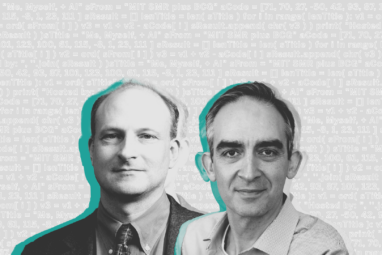Topics
Artificial Intelligence and Business Strategy
In collaboration with
BCG“We tend not to be a company of half measures,” notes Dave Johnson, chief data and artificial intelligence officer at Moderna, “so when we decide we’re going to do something, we’re going to do it.” This characterization certainly seems to fit the Cambridge, Massachusetts-based biotech company that made a name for itself in 2020 upon releasing one of the first COVID-19 vaccines approved by the U.S. Food and Drug Administration for emergency use to combat the coronavirus.
In this bonus episode of the Me, Myself, and AI podcast, our hosts learn how Moderna used artificial intelligence to speed up development of the vaccine and how the technology has helped to automate other key systems and processes to build efficiencies across the organization. Dave also describes Moderna’s digital-first culture and offers insights around collaboration that can be applied across industries.
Subscribe to Me, Myself, and AI on Apple Podcasts, Spotify, or Google Podcasts.
Transcript
Sam Ransbotham: What role did artificial intelligence have in helping combat the coronavirus pandemic? Find out today when we talk with an innovative company that used artificial intelligence to help solve the critical problem society faced in the last year.
Welcome to Me, Myself, and AI, a podcast on artificial intelligence in business. Each episode, we introduce you to someone innovating with AI. I’m Sam Ransbotham, professor of information systems at Boston College. I’m also the guest editor for the AI and Business Strategy Big Idea program at MIT Sloan Management Review.
Shervin Khodabandeh: And I’m Shervin Khodabandeh, senior partner with BCG, and I colead BCG’s AI practice in North America. Together, MIT SMR and BCG have been researching AI for five years, interviewing hundreds of practitioners and surveying thousands of companies on what it takes to build and to deploy and scale AI capabilities across the organization and really transform the way organizations operate.
Sam Ransbotham: Today we’re talking with Dave Johnson, chief data and artificial intelligence officer at Moderna. Dave, thanks for joining us. Welcome.
Dave Johnson: Thanks, guys, for having me.
Sam Ransbotham: Can you describe your current role at Moderna?
Dave Johnson: I’m chief data and AI officer at Moderna. In my role, I’m responsible for all of our enterprise data functions, from data engineering to data science integration. I also manage the software engineering team building unique custom applications to curate and create new data sets [and] also to then take those AI models that are created and build them into processes. So it’s kind of end-to-end everything to actually deploy an AI model — to build, deploy, and put an AI model into production.
Sam Ransbotham: How did you end up in that role? I know you have physics in your background. I didn’t hear any physics in what you just said.
Dave Johnson: It’s a good point. So I have my Ph.D. in what’s called information physics, which is a field closely related to data science, actually. It’s about the foundations of Bayesian statistics and information theory — a lot of what is involved in data science. My particular research was in applying that to a framework that derives quantum mechanics from the rules of information theory. So that part, you’re right, is not particularly relevant to my day-to-day job. But the information theory part and the Bayesian stats [are] completely on target for what I do. In addition to that, I spent many years doing independent consulting in a software engineering data science capacity. And when I finished my Ph.D., I realized academia wasn’t really for me; I wanted to do applications, and I ended up with a consulting firm doing work for large pharmaceutical companies.
So I spent a number of years doing that, and it turned out to be a real great marriage of my skill sets: understanding of science, understanding of data, understanding of software engineering. And so I did one project in particular for a number of years in research at a pharmaceutical company around capturing data in a structured, useful way in the preclinical space in order to feed into advanced data and advanced models — so, very much what I’m doing today. And about seven years ago, I moved over to Moderna. At the time, we were a preclinical stage company, and the big challenge we had was producing enough small-scale mRNA to run our experiments. And what we’re really trying to do is accelerate the pace of research so that we can get as many drugs in the clinic as quickly as possible. One of the big bottlenecks was having this mRNA for the scientist to run tests in. So, what we did is we put in place a ton of robotic automation, put in place a lot of digital systems and process automation and AI algorithms as well. And [we] went from maybe about 30 mRNAs manually produced in a given month to a capacity of about a thousand in a month period without significantly more resources and much better consistency in quality and so on. So then, I just kind of from there grew with the company and grew into this role that we have now, where I’m applying those same ideas to the broader enterprise.
Shervin Khodabandeh: That’s great, Dave. And can you comment a bit on the spectrum of use cases that AI is being applied to here and is really making a difference?
Dave Johnson: For us, what we’ve seen a lot of is in the research space particularly. In Moderna, that’s been because that’s where we digitized early. We see that putting in digital systems and processes to actually capture homogeneous, good data that can feed into that is obviously a really important first step, but it also lays the foundation of processes that are then amenable to these greater degrees of automation. So that’s where we’re seeing a lot of that value, is in this preclinical production — we have kind of high throughput, we have lots of data, we’re able to start automating those steps and judgments that were previously done by humans. One example is our mRNA sequence design. We’re coding for some protein, which is an amino acid sequence, but there’s a huge degeneracy of potential nucleotide sequences that could code for that, and so starting from an amino acid sequence, you have to figure out what’s the ideal way to get there. And so what we have [are] algorithms that can do that translation in an optimal way.
And then we have algorithms that can take one and then optimize it even further to make it better for production or to avoid things that we know are bad for this mRNA in production or for expression. We can integrate those into these live systems that we have, so that scientists just press a button and the work is done for them. And they don’t know what’s going on behind the scenes, but then — poof! — out comes this better sequence for them. And then we’ve seen it with quality-control steps as well.
We’re also doing some work right now with our clinical partners in the clinical operation space in terms of optimal trial planning. We’re doing some work right now around our call center planning. Now that we’re rolling our vaccine out across the whole world, more and more phone calls are coming in, and as we look to launching in new countries, we have to start planning our resources for that. We’re looking at machine learning models to help predict the forecast of these calls so that we can then staff up appropriately. So we do see it across a variety of different areas.
Sam Ransbotham: You mentioned pressing the button — scientists press the button, and some trials happen. What do these scientists think? I mean, you’ve suddenly taken away something that used to be something that they did, and you’re having AI do it. What’s the reaction? Are they thrilled? Are they despondent? Somewhere in between?
Dave Johnson: I’d say closer to the thrilled side. Usually how it works … we’re a company that believes in giving people a lot of responsibility, and people work really hard. And what that leads to is people doing a lot of work. And so what often happens is, folks will come to us and say, “Look, I’m doing this activity over and over. I would really love some help to automate this process.” And so, in that case, they’re thrilled. They don’t want to be looking at some screen of data over and over and over again. They want to be doing something insightful and creative. And so that’s where we really partner with them and take off that component of what they do.
Shervin Khodabandeh: Dave, I want to build on that, because I think you’re putting your finger on something quite interesting. In addition to the financial impact that many get from AI, productivity, efficiency, and all of that — you talked about some of those, Dave — there is an impact in overall organizational culture and teams being more collaborative, higher morale, happier, more confident, etc. Are those some of the things that you guys are seeing as well?
Dave Johnson: For sure. I think one of the sure signs of that is we get a lot of repeat customers. If we do some particular algorithm for somebody, that person comes back with the next one or their team comes back time and time again. We don’t think about AI in the context of replacing humans. We always think about it in terms of this human-machine collaboration, because they’re good at different things. Humans are really good at creativity and flexibility and insight, whereas machines are really good at precision and giving the exact same result every single time and doing it at scale and speed. What we find [to be] the most successful projects are where we kind of put the two together — have the machine do the parts of the job that it’s good at [and] let the humans take over for the rest of that.
Sam Ransbotham: With this freedom, what have people done? You’ve opened up this time. What kind of new —
Shervin Khodabandeh: I got two shots of that, what people have done with that freedom.
Sam Ransbotham: Yeah, actually, there’s at least one product that’s in the market now, isn’t there? I think I’ve heard something on the news.
Dave Johnson: There’s one, yeah. You know, I always like to joke that work is like a gas that always expands to fill the container. So if you take something off somebody’s plate, there’s all this mountain of work that they didn’t even realize just wasn’t being done. And so people are always relieved to then go on and find the next mountain to climb and the next thing to do.
Sam Ransbotham: But what are these kinds of things? How are people choosing how to expand to fill that space?
Dave Johnson: Well, if you think of the examples — like the preclinical quality-control steps that we’ve automated — the reality is, [with] one operator stretched over a huge amount of work, it’s really hard for them to really do really in-depth inspection of these samples. And so by taking off a bulk of that work — 80%, 90%, for the algorithm to do that — what they’re able to do is just do a better, more thorough job of inspecting the samples that are left. It also means we’re not hiring a whole bunch of other people just to go look at screens of data. So it’s a bit of an immediate gain for the people who are there and then kind of this longer-term gain on our head count plans.
Some folks talk about AI in the pharma space being like, “I just want an algorithm that can predict, from the structure of a small molecule, the efficacy in humans,” like that’s the entire drug discovery process. That’s just not going to happen; that’s completely unrealistic. So we just think about the fact that there are countless processes, it’s a very complicated process to bring something to market, and there are just numerous opportunities along the way. Even within a specific use case, you’re rarely using one AI algorithm. It’s often, “For this part of the problem, I need to use this algorithm, and for this, I need to use another.”
Shervin Khodabandeh: Dave, I want to ask you something about the talent base and people. You commented that Moderna is the kind of company that likes to give people a lot of freedom — [a] highly motivated, smart, ambitious team working to do the best it can. How do you bring and cultivate that talent, and what are you finding to be some of the lessons learned in terms of how to build a high-performing team?
Dave Johnson: It’s a good question. I don’t know that — if we look across the company as a whole — there is one particular place where we hire people. We get people from biotechs, [from] five people to pharmas of 100,000 people and everywhere in between, [from] inside the industry and outside the industry. I think for us, it’s always about finding the right person for the job, regardless of where they come from and their background. I think the important thing for us is to make sure that we set expectations appropriately as we bring them in, and we say, “Look, this is a digital company. We’re really bold. We’re really ambitious. We have really high quality standards.” And if we set those expectations really high, it does start to self-select a lot of the people who want to come through that process.
Sam Ransbotham: I want to flip over and talk … You mentioned some of the infrastructure, I would call it, that you put in place that suddenly the world benefited from a few months ago. How did people know to get those things set up in the first place? You mentioned being able to scale from, I think, 30 to a thousand different … How did you know that was the direction, or that was the vision to get those things set up?
Dave Johnson: That’s a great point. The whole COVID vaccine development, we’re immensely proud of the work that we’ve done there, and we’re immensely proud of the superhuman effort that our people went through to bring it to market so quickly. But a lot of it was built on just what you said: this infrastructure that we had put in place where we didn’t build algorithms specifically for COVID; we just put them through the same pipeline of activity that we’ve been doing. We just turned it as fast as we could. When we think about everything we do at Moderna, we think about this platform capability. We were never going to make one drug; that was never the plan. The plan was always to make a whole platform around mRNA because, since it’s an information-based product, all you do is change the information encoded in the molecule, and you have a completely different drug. We knew that if you can get one in the market, you can get any number of them to the market. And so all the decisions we made around how we designed the company and how we designed the digital infrastructure was all around this platform notion that we’re not going to build this for one thing — we’re going to build a solution that services this whole platform. And so that’s exactly why we built this early preclinical staff where we can just crank through quite a few of these. That’s why we built these algorithms to automate activities. Anytime we see something where we know that scale and making it parallel is going to improve things, we put in place this process.
Sam Ransbotham: The proof is certainly in the pudding. One thing that I’m kind of finding fascinating is how normal this all is. I guess I’m just surprised at how much that seems to be part of your … Can I use the word “DNA” here?
Dave Johnson: It’s totally fine.
Sam Ransbotham: RNA.
Shervin Khodabandeh: mRNA. It’s part of their mRna.
Dave Johnson: Yeah, no, it’s true. We were founded as a digital biotech — and a lot of companies say things and put taglines on stuff, but we really meant it. And we have pushed on this for many years, and we’ve built out this for many years.
Shervin Khodabandeh: It’s the platform you built, and now it’s running.
Dave Johnson: It’s the platform approach we take to our data science and AI projects as well. I hear a lot of struggles from folks around, “Great, I built a model and a Jupiter notebook. Now what do I do with it?” As they resolve this data cleansing and data curation to even get it to be in a useful state, then they don’t know where to go from it to deploy it. And we took the same platform approach to our data science activities. We spent a lot of time on the data curation, data ingestion, to make sure the data is good to be used right away. And then we put a lot of tooling and infrastructure in place to get those models into production and integrated. So this platform mentality is just so ingrained into how we think.
Sam Ransbotham: Take us back to early in the COVID race for a vaccine. What was it like being part of that team and a part of that process? I mean, what were the emotions like when the algorithms … or when the people find something that seems to work or that seems promising? Does that lead to a massive appetite for more artificial intelligence and more algorithms? Tell us a little bit about that story.
Dave Johnson: I think if you look at how people felt in general at the time, it was a real sense of honor and pride. We felt very uniquely positioned. We’d spent a decade getting to this point and putting all of this infrastructure in place and putting things in the clinic before this to get to this moment. And so we just really felt truly honored to be in that position. And for those of us on the digital side who have kind of contributed to this and built it, this is why we did it. This is why we’re here: to help bring as many patients [these vaccines] as quickly and safely as possible [throughout] the world. But there was always the question of, “Would this thing work in the real world?” And that’s where the proof came in the clinical data, and we were all anxiously waiting — like everybody else — to see that readout.
Shervin Khodabandeh: Was AI always front and center at Moderna, or has it become more critical as a pillar of growth and innovation over time?
Dave Johnson: I think it’s always been there, though we probably didn’t call it that in the early days; it’s become obviously much more of a hot marketing term than it used to be. But the notion of algorithms taking over decision-making and data science capability was absolutely always there. We were very thoughtful about how we built this digital landscape, such that we’re collecting structured data across all these steps, knowing full well that what we want to do is then turn those into algorithms to do things. So it was very purposeful for that. But I do think it’s also come into a greater focus because we’ve seen the power of it — very recently, obviously. We’ve seen how this digital infrastructure and how these algorithms can really help push things forward. And so it’s gotten that kind of a renewed focus and importance in the company.
We tend not to be a company of half measures, so when we decide we’re going to do something, we’re going to do it. It’s been a very strong message from our senior leadership, about “This is the future of the company — injecting digital and AI into everything we do. Under no uncertain terms, this is happening.” To the point that, as we think about the fact that we’re growing really fast as a company — we just doubled; we’re probably going to double again — we’re bringing in a lot of new folks from outside the company, to grow, who are not necessarily familiar with this digital culture that we’ve had. And so, what we’re working on right now is actually developing what we’re calling an AI academy, which we intend to be a very thorough, in-depth training for our company, from people who would use and interact with AI models on a daily basis to senior leaders who would be responsible [for] a portfolio of potential projects in their areas. And that just shows the level of serious commitment we have about this. We were built on this concept of having a smaller company that’s very agile and can move fast. We see digital as a key enabler for that and AI as a key enabler for that. So the hope is that helps us to compete in ways that other companies can’t. And that is certainly the intention here.
Sam Ransbotham: Dave, thanks so much for talking with us today. We really enjoyed … I mean, you mentioned Moderna hires smart people, and we know that from a sample size of one — that’s clearly true. Thanks for taking the time to talk with us today.
Shervin Khodabandeh: Thank you so much.
Dave Johnson: Absolutely, guys. I really appreciate it.
Shervin Khodabandeh: Sam, that was an awesome conversation with Dave. What do you think?
Sam Ransbotham: Impressive. I’m glad he’s around. I’m glad Moderna is around.
Shervin Khodabandeh: That’s right.
Sam Ransbotham: This is real.
Shervin Khodabandeh: He’s not paying lip service to buzzwords and this, that, and the other. He’s just, “Yeah, we started this way. That’s why we’re doing it. We would not have existed without digital and AI and data and analytics. Of course it’s real. That’s where we are.” He said Moderna is a digital company. That’s what he said.
Sam Ransbotham: It’s just part of their process. Some of the questions, it didn’t even occur to him that it was artificial intelligence; that’s just the way they do things. I wonder if that’s the new … industry after industry, are we going to see the Moderna-type approaches come into industries and just be dominant? The vestiges of historical “Oh, we’ve been around for 100 years” are almost a liability versus a plus.
Shervin Khodabandeh: I think this contrast, Sam, that you were trying to get at, which is, “How come it’s so easy for you guys, and what about the pre/post and the transformation?” He’s like, “Well, we actually started this way. We said we wanted to be a small company.”
Sam Ransbotham: They started post.
Shervin Khodabandeh: Yeah, “We started post. We wanted to be agile, we wanted to be small, we wanted to do a lot more with everything that we had, and so that had to be platform-centric, data-centric, AI-centric, and that’s how we built [the company]. So AI is everywhere. Why are you surprised, Sam, that AI is everywhere? Of course, it’s everywhere. We do it for planning and the trials and sequencing and …” It’s quite energizing and intriguing how it’s just a very different mindset toward AI.
Sam Ransbotham: Right. And I know that we don’t want to make everything AI. There’s a lot that’s going on there that’s not artificial intelligence, so I don’t want to paint it as entirely [AI], but that certainly was a big chunk of the speed story here, and it’s pretty fascinating.
Allison Ryder: Thanks for joining us for this bonus episode of Me, Myself, and AI. We’ll be back in the fall with new episodes for Season 3. In the meantime, stay in touch with us on LinkedIn. We’ve created a group called AI for Leaders specifically for audience members like you. You can catch up on back episodes of the show, meet show creators and hosts, tell us what you want to hear about in Season 3, and discuss key issues about AI implementation with other like-minded people. Find the group at https://mitsmr.com/AIforLeaders, which will redirect you to LinkedIn, where you can request to join. We’ll put that link in the show notes as well, and we hope to see you there.







